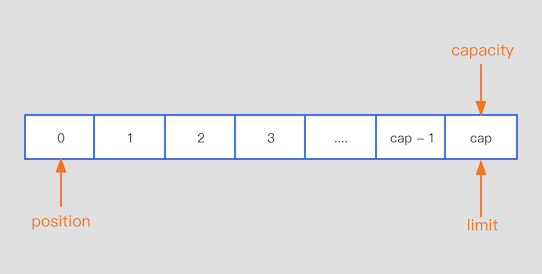NIO - HeapByteBuffer
大约 2 分钟
NIO - HeapByteBuffer

上篇文章介绍了堆外内存 DirectByteBuffer,我们知道了 DirectByteBuffer 是分配在 JVM 堆外的 ByteBuffer,这篇文章来了解堆内内存 HeapByteBuffer。
HeapByteBuffer
HeapByteBuffer,即分配在 JVM 中的 heap 堆中的 ByteBuffer,调用 ByteBuffer#allocate() 即可生成一个 HeapByteBuffer 对象。
public static ByteBuffer allocate(int capacity) {
if (capacity < 0)
throw new IllegalArgumentException();
return new HeapByteBuffer(capacity, capacity);
}
这里我们可以看到它是直接 new 一个 HeapByteBuffer 对象。
// package 级别
HeapByteBuffer(int cap, int lim) {
super(-1, 0, lim, cap, new byte[cap], 0);
}
直接调用父类构造函数:
ByteBuffer(int mark, int pos, int lim, int cap,byte[] hb, int offset){
super(mark, pos, lim, cap);
this.hb = hb;
this.offset = offset;
}
从构造函数中我们可以看到它是构造一个 position = 0、capacity = cap、limit = cap 的 ByteBuffer 对象,如下图:

HeapByteBuffer 的底层实现就是一个 byte 数组,所有的操作都是基于该数组的,如 put 和 get 操作。
// put
public ByteBuffer put(byte x) {
hb[ix(nextPutIndex())] = x;
return this;
}
// get
public byte get() {
return hb[ix(nextGetIndex())];
}
至于回收,那就是 JVM 的事情了。
DirectByteBuffer VS HeapByteBuffer
- DirectByteBuffer 相比 HeapByteBuffer 的优势在于 IO 操作时能够节省一次数据拷贝,同时对于一些 NIO 框架而言,也会选择 DirectByteBuffer,原因在于尽管 HeapByteBuffer 是在 JVM Heap 上分配,但是Java NIO 在读写相对应的 Channel 时,会先将 Java Heap 的 buffer 内容拷贝到直接内存 — Direct Memory 中,这样就让 DirectByteBuffer 的 IO 性能明显强于 HeapByteBuffer,因为它省去了临时 Buffer 的拷贝开销。
- 对于磁盘 IO(文件),DirectByteBuffer 依然可以使用内存映射来提升性能,所以对于 IO 场景而言,DirectByteBuffer 的性能是优于 HeapByteBuffer 的。
- 同时,DirectByteBuffer 对 GC 也有一些改善,使应用的 GC 压力更小。因为堆外内存不归 JVM 管,它直接受操作系统管理,这就会让 JVM 能够保持一个较小的堆内存,减少 GC 操作对应用的影响。由于 DirectByteBuffer 不归 JVM 管,所以它的回收只能依靠 full gc 了,当然我们也可以手动释放 DirectByteBuffer:
- 反射。通过反射的方式调用 DirectByteBuffer 中的 Cleaner 的
clean()方法。
- 反射。通过反射的方式调用 DirectByteBuffer 中的 Cleaner 的
- DirectByteBuffer 的创建会比 HeapByteBuffer 慢些,因为 HeapByteBuffer 直接在 JVM 堆上分配内存就可以了,速度杠杠的,但是 DirectByteBuffer 还需要调用 native 的 malloc 来分配内存,效率肯定会差些。
在后面的【死磕 Netty】专栏,大明哥还会继续深入分析堆外内存和堆内内存。